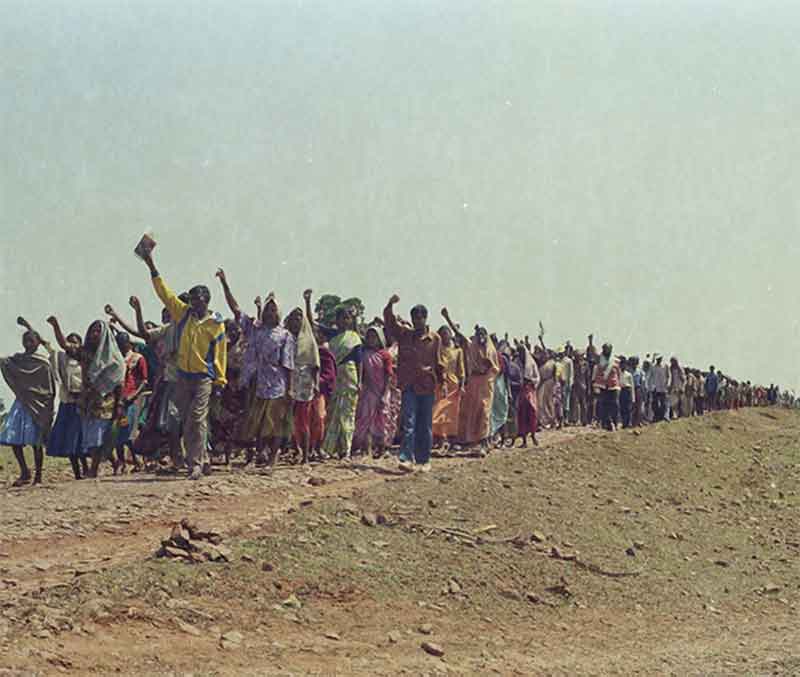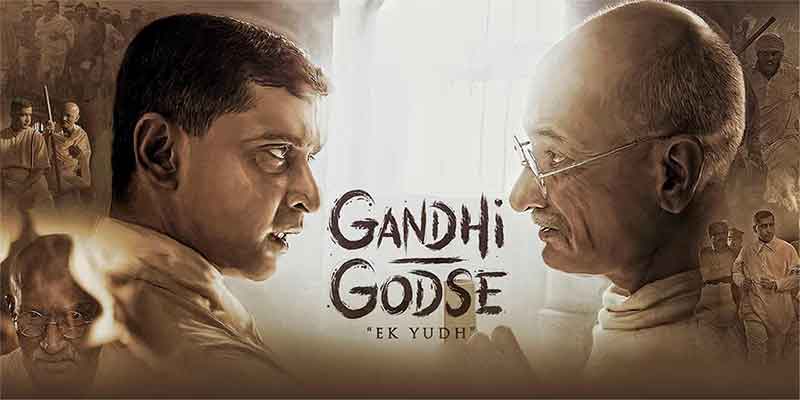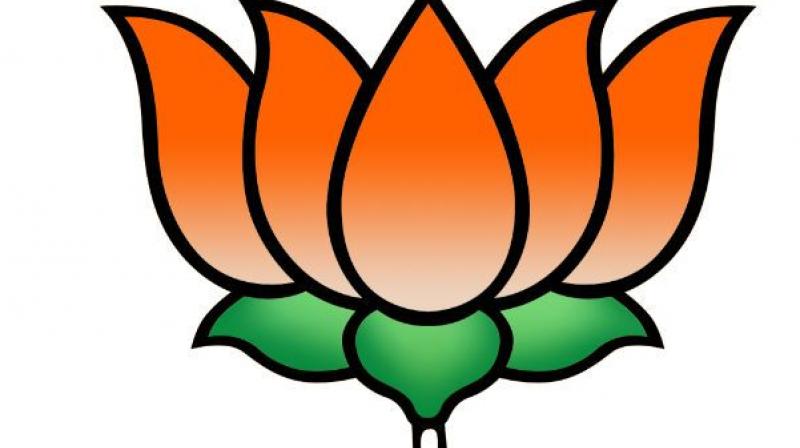
The way BJP has openly come on communal polarization in the current elections, and most of all seeing their leadership people number one Narendra Modi and number two Amit Shah, I got inspired to write this article. I am compelled to write this article to confess my association with the Sangh Parivar. I was involved in Jayaprakash Narayan’s movement when I was just 20 years old. And at the age of 23, I went to jail due to the Emergency. Before that, the people of the Rashtriya Swayamsevak Sangh helped me a lot in staying underground during the Emergency. And they generously tried to provide me with food, accommodation and other essential items. And my public life started at the age of 12 by going to the RSS branch. In a way, I have eaten the salt of the RSS, though for a short time.
And the first introduction of the fascist form of the Sangh was the act of writing an apology letter to get out of jail for implementing Mrs. Indira Gandhi’s 20-kalam program, while in jail during the emergency situation. That too in the name of a strategy. And we have nothing to do with Jaiprakash Narayan’s movement. The act of writing such a lie by undertaking, exactly the same was done by barrister Savarkar to the British (1911) “I Vinayak Damodar Savarkar, to strengthen the empire of Her Majesty the Queen of Britain, influenced by me, young people, misguided by me, get me out of jail and see what I will not do to strengthen the British Empire?” More than half a dozen such letters of apology have been found in the archives of Savarkar.
And after seeing this correspondence signed by RSS chief Balasaheb Deoras during the Emergency, I came to know about the hypocrisy of the RSS people in jail. And I started hating the RSS people. I felt that they are hypocrites. And these people can do anything in the name of strategy. And the belief that these people must have killed Mahatma Gandhi also became strong.
During the rule of Janata Party (1977-80) I saw their hypocrisy with my own eyes, I even had a quarrel with their leaders like Nanaji Deshmukh and Vasant Bhagwat over the distribution of Lok Sabha seats of Vidarbha. And whether it is the highest officer of the Sangh or an ordinary volunteer, they are not humans but robots coming out of the branches. And as per the program set, they also behave accordingly. The most confusion started to be cleared when Narendra Modi was the Chief Minister of Gujarat at the time of Babri Masjid demolition and Gujarat riots. I have seen the first state-awarded riot in the history of Indian riots.
And the bomb making factory running in the house of RSS volunteer Rajkondawar in Patbandhare Nagar, Nanded, Maharashtra and the bomb blast that happened due to technical fault in it, in which the body of a young boy named Naresh of Rajkondawar was blown to pieces (on 6 April 2006). And to divert attention from that, within two months (on the night of 1 June 2006) at 3 am, a so-called suicide attack was carried out in the old RSS building named Mahal in Nagpur. And after that the Malegaon bomb blasts of 2006 and 2008, which I investigated only because of the request of my journalist friend Praful Bidwai. And there is no doubt left in my mind that RSS can do anything to create communal polarization in the country.
The second Sarsanghchalak of the RSS, Shri. Madhav Sadashiv Golwalkar (1940-73) felt the need for a political party under his own control, despite the existence of the Hindu Mahasabha, and founded the Bharatiya Jana Sangh in 1950. In the 27 years from 1950 to 1977, the Jana Sangh was voted for by only six percent of the voters. But after 1963, Dr. Ram Manohar Lohia’s non-Congress political move, alliances with deeply communal parties ranging from Shiv Sena to Muslim League and Jana Sangh, benefited the Jana Sangh, Shiv Sena and to some extent the Muslim League. In 1967, the United MLA Party governments were experimented with. And the Jana Sangh benefited the most from it. The RSS and Hindu Mahasabha used to hide their faces because of the assassination of Mahatma Gandhi in 1948. Due to their participation in the movement of Dr. Ram Manohar Lohia and after his death (1967) (1973-75) Jayaprakash Narayan, Sangh-Janasangh got a great opportunity to establish itself. And before the emergency and the elections held after that in 1977, Jayaprakash Narayan urged that to remove the Congress government at the centre, all non-Congress parties should unite and contest the 1977 elections under one party and one election symbol. And for this reason, the Janata Party was established on 1 May 1977 at Pragati Maidan in Delhi by combining the Socialist Party, Organisation Congress, Jansangh, Chaudhary Charan Singh’s Bharatiya Kranti Dal and the parties of Jagjivan Ram and H.N. Bahuguna.
And Janata Party gave a tough fight to Congress in the region of North India and everyone from Prime Minister Indira Gandhi to her son Sanjay Gandhi lost elections. But Raj Narayan had first written to Morarji Desai a year ago about the dual membership of Jan Sangh and Rashtriya Swayamsevak Sangh and the interference of Sangh in the day to day work of Janata Party. But Morarji Bhai ignored it. And Madhu Limaye and George Fernandes together, after toppling the Janata Party government, the people of the old Jan Sangh founded the Bharatiya Janata Party in 1980. And this party, for its political existence, sometimes started a movement to ban cow slaughter and sometimes on local religious places, for example, in 1985-86 after the issue of Shah Bano’s divorce, “The question is of faith, not of law.” By taking up this slogan, it fueled the Babri Masjid-Ram Mandir movement around it. And during that time Ramanand Sagar’s Ramayana serial was running on Doordarshan which helped a lot in spreading the Ramjanmabhoomi temple movement. After that BJP under the leadership of Lal Krishna Advani started the politics of Rath Yatras from Somnath.
And during the same Shila Puja Yatra, on 24 October 1989, the Bhagalpur riots took place. Seeing this, I felt that “the central focus of Indian politics for the next fifty years will be only and only around communalism”. Which I wrote and spoke about at least at more than a hundred places. “That all the movements going on regarding our everyday issues, from displacement, employment, farmers, laborers to Dalits and tribals, will not be able to stand in front of religious polarization. And the entire politics will revolve only around communalism.” I had tried to say this for a decade from 1990-2000. But I don’t know, maybe my way of expression was wrong, or I could not say my point very effectively, because all the people who heard and read it were very militant and honest people in the public sector. But today, after 35 years, what is the scene we are seeing? Lal Krishna Advani has played the biggest role in preparing the ground for communal polarization for Narendra Modi. That is why Narendra Modi has honored him with Bharat Ratna award. Otherwise what other contribution has LK Advani made? Narendra Modi is just harvesting the thriving crop sown by his predecessors.
And three years later, on 6 December 1992, the Babri Mosque was demolished. And after continuously leading a so-called movement around the slogan ‘Mandir Wahin Banayenge’ for thirty-five years, on 27 February 2002, Narendra Modi rushed to Godhra, two hundred kilometres from Gandhinagar, on hearing the news of 59 people being burnt to death in the fire that was set on the Sabarmati Express train carrying karsevaks returning from Ayodhya at Godhra station. And after stopping the post-mortem of the burnt bodies at Godhra station under the supervision of Godhra Collector Jayanti Ravi and handing over the 59 half-burnt bodies to the Gujarat state president of the Vishwa Hindu Parishad, the next day those bodies were loaded on open trucks and a procession was taken out on the streets of Ahmedabad. This has played the biggest role in inciting people against Muslims.
And in a cabinet meeting Narendra Modi, being the Chief Minister, asked the police and administration to give free hand to the violent riots in Gujarat. And this was said by two police officers who heard this. And a minister named Haren Pandya also told Justice Krishna Iyer committee under oath that “Narendra Modi had told all the ministers and police-administration employees present in the cabinet meeting that “no one will stop whatever reaction will be made by the people of Hindu religion in Gujarat tomorrow.” And that is exactly what happened. And surprisingly, Narendra Modi himself wrote a letter to the center on 28 February to send the army. And 3000 military soldiers from Jodhpur were landed in sixty aeroplanes at Ahmedabad airport from the evening of 28 February under the leadership of Lieutenant General Jamiruddin Shah. But the local administration procrastinated in providing logistics to our army soldiers. On whose orders was the local administration not cooperating? Why did no investigation commission take cognizance of this? And after that why did the SIT sent by the Supreme Court also not pay any attention to this matter? If proper action had been taken on all these aspects, then today Narendra Modi would have automatically become the Prime Minister. How could he claim to have been given a clean chit by the Supreme Court?
Lieutenant General Jamiruddin Shah reached the Chief Minister’s residence in Gandhinagar at 2 o’clock in the night in a jeep that he had brought with him. He saw that India’s then Defence Minister George Fernandes and Narendra Modi were having dinner. George Fernandes himself got up and waved his hand to Lieutenant General Jamiruddin Shah and said, “General Sahib, please help us save Gujarat.” Jamiruddin Shah said, “Our 3000 soldiers have reached Ahmedabad airport since the evening. But no responsible officer of the Gujarat government answered our phone. That is why I had to come to the Chief Minister’s residence so late at night with the help of a local guide and driver. We saw from our flight that the fire of riots is raging in the whole of Gujarat. Tell the Chief Minister to give us logistics.” And George Fernandes asked Jamiruddin Shah to give logistics to Narendra Modi. But despite that, our country’s army remained at the Ahmedabad airport for another 24 hours. What does this mean? BJP people always say about the army that the morale of our army should not be lowered. So, on one hand Narendra Modi, as the Chief Minister, wrote a letter to the Government of India to send the army to stop the riots in Gujarat, and on the other hand, the same army was allowed to stay inside the Ahmedabad airport for 24 hours. Was this a very good behavior to raise the morale of the Indian army? And what happened in Gujarat after that? The whole world knows this. After seeing the riots in Gujarat, the then Prime Minister Atal Bihari Vajpayee said to Narendra Modi, “You did not follow the Rajdharma.” And the height of Narendra Modi is such that he told Atal Bihari Vajpayee, “Sir, that is what I am doing.” Which Rajdharma is Narendra Modi following? On 27 February, he loaded 59 half-burnt bodies on open trucks from Godhra and took out a procession on the streets of Ahmedabad on 28 February and told the police, administration and his ministers in a cabinet meeting that no one will stop whatever happens in Gujarat tomorrow. Was this a decision of a Chief Minister to follow Rajdharma?
And after the same riots, Narendra Modi, who used to wear a 44-inch vest, got his chest expanded to 56 inches, and while projecting himself as the ‘Hindu Hriday Samrat’, reached the position of Prime Minister of India. In his 11-year tenure, he did nothing except filling the coffers of a few rich people. On the contrary, in order to collect thousands of crores of rupees as donations for his party in the name of so-called electoral bonds, he has forcibly forced the ED, CBI, Reserve Bank, State Bank of India and other government banks to do this illegal business. And the most surprising thing is what kind of contracts have been given to those from whom the donations were taken? This is coming to light after the Supreme Court’s decision.
I have been writing the same thing for the last 35 years, after seeing the Bhagalpur riots of 1989. But many of my colleagues thought it was an exaggeration. I had said that “In the next 50 years, the issue of communalism will dominate the centre of Indian politics, and the day-to-day issues of the people will become secondary and the issues of the people of our country like unemployment, displacement, education, health, environment, inequality, inflation, injustice and atrocities against women, Dalits, tribals, everything will become secondary issues. And only the issue of communalism will remain.” But at that time I have been unsuccessful in explaining this to any of the colleagues working on our issues. I regret this again and again.
The Sangh Parivar which did not participate in the freedom struggle, did not accept the Constitution, did nothing for poverty, unemployment, tribals, Dalits, labourers and farmers. Today, they have become politically dominant by just creating communal polarization.
Subscribe to Our Newsletter
Get the latest CounterCurrents updates delivered straight to your inbox.
On 22 April, terrorists brutally killed 26 people in Pahalgam. But when our country’s Prime Minister was the Chief Minister of Gujarat, he reached Godhra, 200 kms from Gandhinagar, after the Godhra incident. Similarly, he also reached Mumbai after the 26/11 attack in Mumbai. And even after the so-called suicide attack on the RSS headquarters on 1 June 2006, he came to Nagpur. And regarding this act, senior journalist Mr. Kuldeep Nayyar has also written an article in the Deccan Herald newspaper raising a constitutional question on the subject, Why did the Chief Minister of one state reach the incident of another state? But after getting information about the Pahalgam incident, the Prime Minister who had gone to Saudi Arabia left his trip midway and returned to India. Instead of addressing the meeting of the leaders of all the opposition parties on the Pahalgam incident, he addressed an election rally in Bihar. Meaning, in order to form the BJP government in Bihar elections on the Pahalgam incident, his favorite phrase which he used to say during a terrible disaster like Covid is “looking for opportunity in disaster”.
Dr Suresh Khairnar is Ex. President of Rashtra Sewa Dal















































